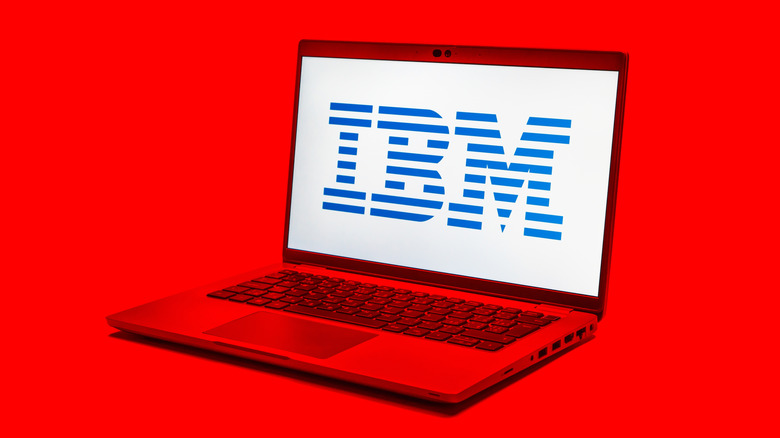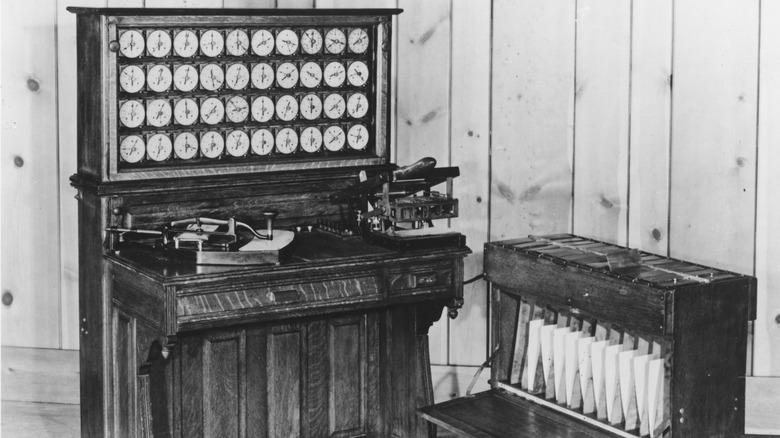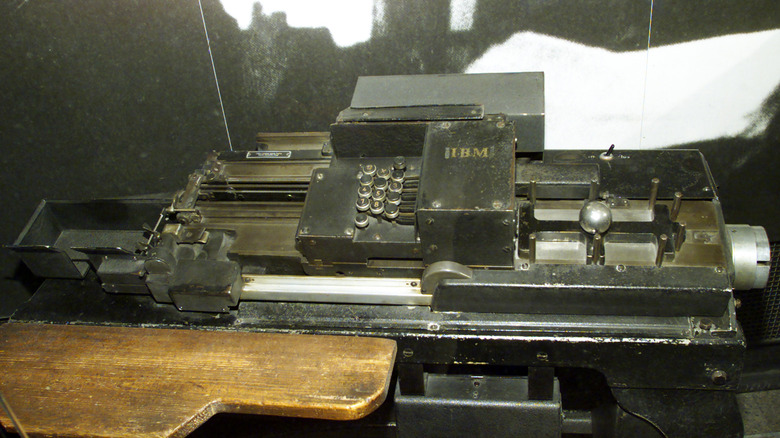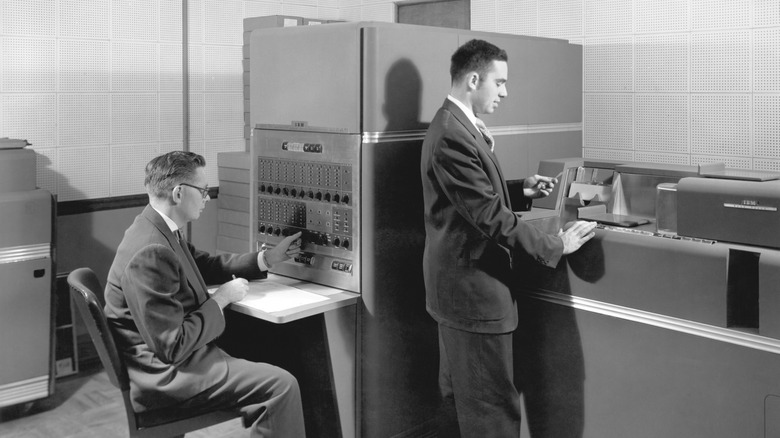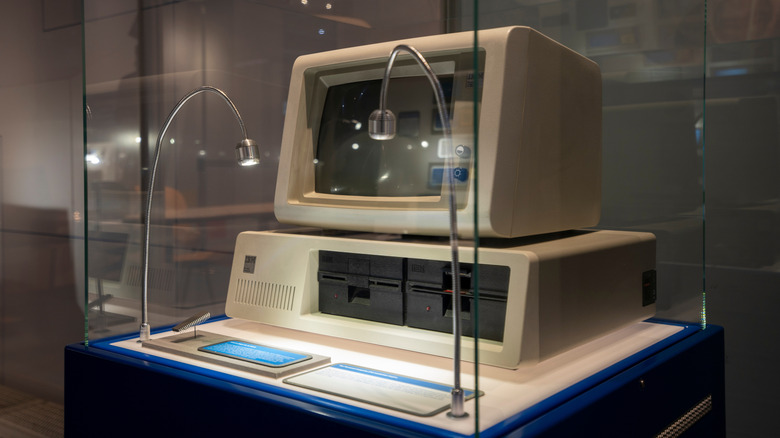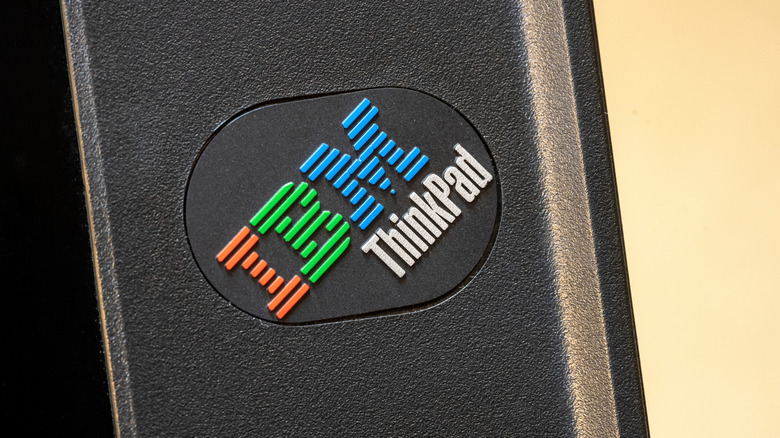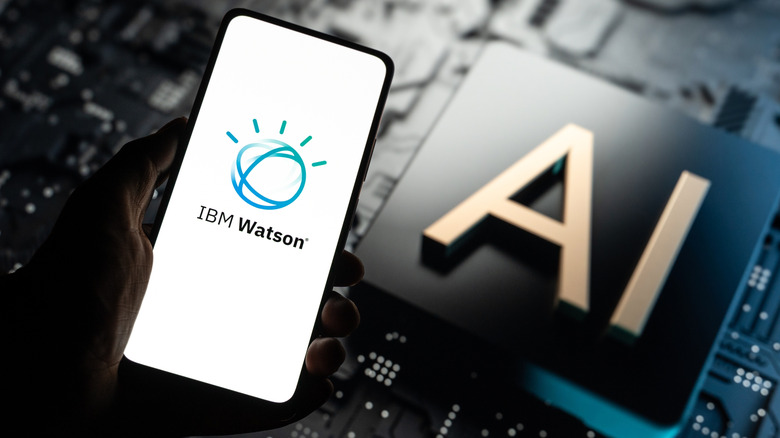What Does IBM Stand For And Why Is It Important In Computer History?
In the annals of computer history, few names are as venerated as IBM. The company, eventually known as International Business Machines, remained on the bleeding edge of computer technology for decades. Its operations grew on the back of innovative punch-card technology that helped to usher in a renaissance in record-keeping during a time when industrialization was exploding across the globe. Thereafter, it oversaw the rise of mainframe computing, and it was among the first companies to crest the wave of the PC revolution.
While IBM (or Big Blue as those in the industry colloquially call it) is far less powerful today than it was at the pinnacle of its success, it nonetheless remains far more integral to the computer landscape than you might imagine. To trace the history of IBM is to see, in broad strokes, the history of the computer, which eventually became a cornerstone of modern life. So, just how did the enormously influential operation get its start? IBM was a titan that eventually lost its dominance to younger upstarts. The history of IBM begins in a New York City board room, and it has not ended yet. So, here's how International Business Machines got its name and took the tech world by storm.
The early 20th century origins of IBM
The companies that would eventually merge to become IBM were on the cusp of technologies which, in the first decade of the 1900s, were becoming more important by the day. Financier Charles Ranlett Flint invested in several of them, including time clock technology. Prior to the time clock, which allowed employers to precisely measure how long their employees worked, it was difficult to keep track of work. In the era of industrial manufacturing, with large workforces toiling on assembly lines, time clocks proved essential. Flint also invested in computing scales, which had value, but the real diamond of the bunch was the tabulating machine.
Flint negotiated a merger between these disparate interests, resulting in a company called CTR. The tabulating machine was its premier offering. The card punch machine, invented by Hermann Hollerith in 1884, was the size of a desk, and was used to tabulate large sums of data about people. It had already been used in the 1890 U.S. census, and was deployed at railroads, and some consumer businesses too.
However, it became clear that CTR needed centralization, so in 1914, Flint hired Thomas J. Watson to act as general manager. It was Watson who renamed the company as International Business Machines. Under his stewardship, it would go on to become one of the most influential businesses of the century. As its most successful product, IBM continued to iterate on the Hollerith tabulating machine, in 1933 releasing models that could do multiplication. That was also the year IBM snapped up Electromatic Typewriters, Inc., adding yet another crucial technology to its portfolio.
IBM's shameful history during WWII
By the time war engulfed the globe for a second time, IBM was a multinational corporation. During World War II, IBM's paths diverged between the German and American arms of its business. In America, it was business as usual. But a continent away, the Nazis, well-known today as meticulous documentarians and record keepers of their atrocities, had a high demand for IBM's Hollerith punch-card systems. IBM's German branch was one of several large, American companies that kept the Third Reich's death machine churning. In 2002, documents uncovered by Holocaust historian Edwin Black alleged that IBM supplied punch-card machines that calculated how many people should be transported to concentration camps each day, and aided with the logistics involved in the occupation of Poland. It's unclear the extent to which IBM was aware of how their machines were being used, but continued to supply the machines until America formally declared war against Germany in 1941. However, the business remained intact, and profits flowed back to IBM's New York headquarters through its office in Geneva.
For its part, IBM has refused to cooperate with Black or other historians. It has never outright denied being complicit in the Holocaust, and has acknowledged its equipment was used by the German regime, but any acknowledgment downplays the purported scale of IBM's involvement and the complex channels through which it continued to profit during the war. Nonetheless, IBM continued to dominate the fields of emerging technology in the postwar period.
IBM in the postwar period: the computer age
Flush with cash after WWII, IBM was flourishing in the postwar period. This was also when computer technology began to come into its own with the rise of mainframe computers. Technology had advanced during World War II, and as a leader in data processing, IBM was well positioned to meet the new whirlwind of innovation. Although the introduction of computers cannibalized Hollerith sales, the shift was necessary if IBM was to remain a leader in the space.
Other companies beat IBM to the computer market, but as Apple continuously proves today, latecomers often fare better than pioneers in the tech industry. IBM's first computer, the IBM 701, bowed in 1952. It was not a consumer-facing machine, or even enterprise focused, but was used by defense and aerospace contractors like Boeing, Lockheed, and the National Security Agency (NSA). This was followed up with the commercial IBM 650, which in 1954 became a wide success. Scientific institutions like Columbia University, as well as by commercial clients used it. The 650 and subsequent models were behemoth machines. The CPU alone spanned 30 square feet and weighed 1966 pounds. It was wildly expensive to rent and maintain.
In today's terms, it had less computing power than a cheap calculator you can buy at a dollar store now. But for the time, it was a marvel of modern technology, and it laid the groundwork for IBM to dominate the computer landscape. Even the simplest of gadgets today has more computing power than these gargantuan computers, but they continued to become integral to modern businesses with each subsequent generation.
The rise and fall of a tech titan
Through the 1970s, IBM continued to make strides. Robert Dennard, an IBM engineer, invented the first dynamic random access memory (DRAM) in 1966, a technology that remains fundamental in computer systems to this day. In 1969, even amid an antitrust case over its market dominance, IBM's computers were integral to the success of the first moon landing. By the early '70s, innovations sallied forth at a breakneck pace, and 1971 alone saw IBM introduce a speech recognition technology as well as the Floppy Disk. In 1973, IBM researcher Dr. Leo Esaki received the Nobel Prize in physics.
By the end of the decade, the computer world was on the cusp of a new revolution as personal computers began to enter the market. IBM's efforts in that arena were wildly successful, at least in the beginning. The IBM Personal Computer was late to the market, arriving in 1981, but is still considered one of the most influential computers in history. But upstarts were beginning to nip at IBM's heels. The age of Silicon Valley was dawning, and inventions were being brought to life in unremarkable suburban garages. One company to emerge from the new paradigm was Apple, whose founder, Steve Jobs, introduced the Apple II in 1977, recognized as the start of the PC revolution.
In this milieu, the market was at first hungry for a PC from a known quantity like IBM. But despite the $1 billion in sales the IBM PC did in its first year, that success can be retrospectively viewed as a high water mark. While it did cement Intel and Microsoft as the hardware and software cornerstones of the PC market, those companies didn't need IBM in the long run. The IBM era was coming to a close.
How IBM lost the race for personal computers
After the explosive success of the IBM PC, you might think the PC division of the company would be its new focus. But the CEO at the time, one John Opel, had little understanding of its importance and tampered down on that side of the business. After all, the PC was selling like hotcakes and IBM overall was the most valuable company in the world in the early 1980s.
When the other shoe dropped and IBM executives realized that, far from a curio, personal computers would be the future of modern life, it was too late. Don Estridge, the father of the IBM PC, saw his team balloon from 4,000 to 10,000 as it was folded more deeply into the company. Looking to capitalize on its success, IBM developed a smaller, cheaper PC geared more directly toward households rather than offices. And when it released, everything went off the rails.
The PCjr, or Peanut as it was nicknamed, was hated from the get-go. Ironically, one of its most hated aspects was the chiclet keyboard, a style of keyboard that characterizes nearly all laptops today. The PCjr turned out to be the tipping point for IBM, as not even their own salespeople wanted to recommend it to customers. And, as other companies entered the PC market, their products continuing to become cheaper and more powerful, IBM's partners, Intel and Microsoft, reaped the benefits while leaving it behind. In the ensuing decades, its market share continued to shrink. Its proprietary PC operating system, OS/2, lost out to Windows. In December 2004, IBM finally threw in the towel, selling its PC business to Lenovo and marking the end of its imperial age.
IBM today: an unseen giant
Empires don't die all at once. Instead, they often fade into obscurity. Once a builder of the most powerful supercomputers in history, IBM is now an also-ran. In the wake of its fall from the top of the computer business, IBM pivoted to software, infrastructure, and consulting. These behind-the-scenes efforts have sustained the company into the present day. While it is no longer the dominant force it once was, it still wields a market cap of $208.6 billion — no Microsoft or Apple, but certainly a major player.
IBM's current business includes a large cloud component with which the company is rapidly expanding into enterprise AI infrastructure for large data analysis. That's par for the course for any major tech company in 2024 and beyond, but more risky for IBM than most given its lack of fallback options should the AI boom bust. And on the software end, Big Blue provides enterprise tools such as IBM Watson, a platform named after its formative CEOs that focuses on natural language processing, machine learning, and more. The latest iteration of this is Watsonx, which lets clients train and distribute generative AI models. There are still some hardware efforts, such as the 2 nanometer IBM chips we saw a few years back.
While IBM is far from the titan it used to be, nothing can take away its mammoth presence in the pages of computer history. From proto-computing innovations like the Hollerith tabulating machine to early mainframe computers, and to the dawn of the PC revolution, big blue has played a central role in shaping the now-ubiquitous technology of our time.
